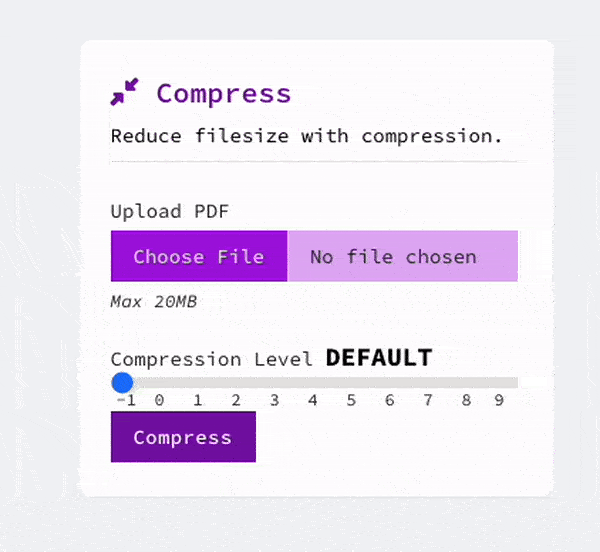- Jan 29
How to Compress a PDF & Reduce Filesize
Reduce PDF filesize and streamline your distributions.
File size matters. Whether you're emailing a document, uploading it to a website, or storing it on a device with limited space, large PDF files can be a hassle. Fortunately, compressing PDFs can solve these issues without compromising too much on quality. In this post, we’ll explore the benefits of PDF compression, common use cases, and how to use the PDF Conduit compression tool effectively.
How to Compress PDFs with PDF Conduit
-
Visit the PDF Compression Tool
Navigate to the PDF Conduit Compression tool -
Upload Your PDF
Click “Upload PDF” and select your file (up to 20MB). -
Select Compression Level
Choose from levels ranging from-1(default) to9(maximum compression). Higher levels reduce size more but may slightly affect quality. -
Click “Compress”
The tool will process your file and generate a smaller version for download. -
Download Your Compressed PDF
Once processing is complete, download the optimized file to your device.

Compressing PDFs is an easy yet powerful way to improve file sharing, storage, and performance. PDF Conduit provides a simple and effective way to reduce file sizes. Try it today and experience faster, more efficient document handling!
Why Compress PDFs?
-
Faster Uploads and Downloads
Large files take longer to upload and download, which can be frustrating when dealing with slow internet connections. Compression reduces file size, making transfers much quicker.
-
Saves Storage Space
Whether you're storing PDFs on your device or in the cloud, reducing file size helps save valuable storage.
-
Easier Email Attachments
Many email services have attachment size limits (often around 25MB). If your PDF is too large, compression can ensure it stays within those limits.
-
Better Website Performance
If you’re hosting PDFs online for users to download, smaller files mean faster load times, improving the user experience.
-
Optimized for Mobile Viewing
Mobile devices have limited processing power and storage. Smaller PDFs load faster and open more smoothly on smartphones and tablets.
Common Use Cases for PDF Compression
-
Graphic-Heavy PDFs
PDFs containing images, graphs, or scanned pages can be bulky. Compression reduces size while keeping visuals clear.
-
Archiving & Backups
If you need to store large numbers of PDFs for reference, smaller file sizes will maximize available storage.
Common Questions
-
Does compression reduce quality?
Yes, but the impact varies based on the compression level you choose. Lower compression preserves quality better, while higher compression results in a smaller file with minor quality loss.
-
Can I compress password-protected PDFs?
No, you’ll need to remove password protection before compression. You can use PDF Conduit’s decrypt tool to unlock files first.
All Your PDF Needs, Simplified and Affordable
Say goodbye to complicated software and high costs. With PDF Conduit, streamline your PDF processing—merge, encrypt, convert, and more—all from your browser. Starting at just $3/month, we're designed to make your workday easier without breaking the bank.
- Try PDF Conduit out for free and process up to three (3) PDFs without signing up for an account
- If you think PDF Conduit might fit your needs but you aren't totally convinced yet, sign up for a free account and process up to twenty (20) PDFs per month free of charge